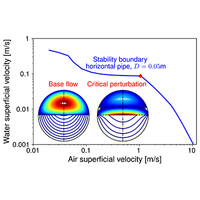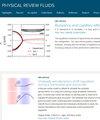Instability of stratified air-water flows in circular pipes
IF 2.5
3区 物理与天体物理
Q2 PHYSICS, FLUIDS & PLASMAS
引用次数: 0
Abstract
This work deals with the stability of two-phase stratified air-water flows in horizontal circular pipes. For this purpose, we performed a linear stability analysis, which considers all possible three-dimensional infinitesimal disturbances and takes into account deformations of the air-water interface. The main results are presented in the form of stability maps, which compare well with the available experimental data. The neutral stability curves are accompanied by the corresponding wavenumbers and wave speeds of the critical perturbations, as well as by spatial patterns of their velocity components. Accordingly, several modes of the critical perturbation are revealed. Long waves are found to be the critical perturbation over part of the stability boundary, and they are affected by the surface tension due to the confinement effect of the lateral direction. Exploring the effect of pipe diameter on the stability boundary and critical perturbations shows that for small water holdups (i.e., thin water film) the scaling of the critical gas velocity by the gas Froude number is valid for pipe diameters larger than about 0.1 m, where the surface tension effects due to the lateral confinement become negligible. Comparing results obtained in pipe, square-duct, and two-plate geometries, we show that there are cases where the simplified geometry of two parallel plates can be employed to model the realistic geometry reasonably well.

圆管中分层气水流的不稳定性
本研究涉及水平圆管中两相分层气水流的稳定性。为此,我们进行了线性稳定性分析,考虑了所有可能的三维无穷小扰动,并考虑了气水界面的变形。主要结果以稳定图的形式呈现,与现有的实验数据对比良好。中性稳定曲线附有临界扰动的相应波数和波速,以及其速度分量的空间模式。因此,临界扰动的几种模式被揭示出来。研究发现,长波是部分稳定边界上的临界扰动,由于横向的约束效应,长波受到表面张力的影响。探索管道直径对稳定边界和临界扰动的影响表明,对于小的水滞留(即薄水膜),临界气体速度与气体弗劳德数的比例关系在管道直径大于约 0.1 米时是有效的,此时横向约束产生的表面张力效应变得可以忽略不计。通过比较管道、方形导管和双板几何结构的结果,我们发现在某些情况下,可以使用两块平行板的简化几何结构来合理模拟实际几何结构。
本文章由计算机程序翻译,如有差异,请以英文原文为准。
求助全文
约1分钟内获得全文
求助全文
来源期刊

Physical Review Fluids
Chemical Engineering-Fluid Flow and Transfer Processes
CiteScore
5.10
自引率
11.10%
发文量
488
期刊介绍:
Physical Review Fluids is APS’s newest online-only journal dedicated to publishing innovative research that will significantly advance the fundamental understanding of fluid dynamics. Physical Review Fluids expands the scope of the APS journals to include additional areas of fluid dynamics research, complements the existing Physical Review collection, and maintains the same quality and reputation that authors and subscribers expect from APS. The journal is published with the endorsement of the APS Division of Fluid Dynamics.
 求助内容:
求助内容: 应助结果提醒方式:
应助结果提醒方式:


